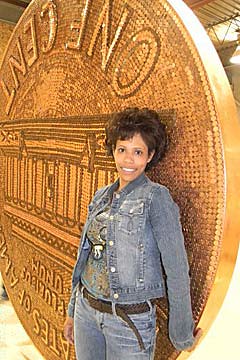
About UsThe Numismatic Bibliomania Society is a non-profit organization promoting numismatic literature. For more information please see our web site at coinbooks.org SubscriptionsThose wishing to become new E-Sylum subscribers (or wishing to Unsubscribe) can go to the following web page link MembershipThere is a membership application available on the web site Membership Application To join, print the application and return it with your check to the address printed on the application. Membership is only $15 to addresses in the U.S., $20 for First Class mail, and $25 elsewhere. For those without web access, write to: David M. Sundman, Secretary/TreasurerNumismatic Bibliomania
Society AsylumFor Asylum mailing address changes and other membership questions, contact David at this email address: dsundman@LittletonCoin.com SubmissionsTo submit items for publication in The E-Sylum, just Reply to this message, or write to the Editor at this address: whomren@coinlibrary.com
BUY THE BOOK BEFORE THE COINYou won't regret it! |
- WAYNE'S WORDS: THE E-SYLUM FEBRUARY 20, 2011
- SKLOW MAIL BID SALE NO. 12 RESULTS
- BOOK REVIEW: GUIDE BOOK OF U.S. COINS, PROFESSIONAL EDITION, 2ND EDITION
- ARTICLE REVIEW: CALIGULA'S QUADRANS
- THE VICTORIA CROSS LIBRARY
- THE TOP SELLING NUMISMATIC BOOKS ARE – ALBUMS!
- MORE ON DEALER STEVE TANENBAUM
- FALLEN PHOTOGRAPHER'S VIRGIN MARY MEDAL RECOVERED IN VIETNAM
- MÜNZKABINETT WINTERTHUR OF SWITZERLAND CELEBRATES 150 YEARS
- MORE ON 1945 NICKELS WITHOUT MINTMARKS
- AN INTERVIEW WITH ANA MONEY MUSEUM CURATOR DOUGLAS MUDD
- QUERY: MINTAGE FIGURES FOR COMMEMORATIVE DOLLARS 2007-2010 SOUGHT
- MORE ON WHO SAID STEPHEN NAGY WAS JOHN HASELTINE'S SON-IN-LAW?
- MOY'S "DIRECTOR'S COIN FOR EXCELLENCE"
- READER THOUGHTS ON THE GIANT PENNY: IS IT ART?
- NOTES FROM E-SYLUM READERS: FEBRUARY 20, 2011
- 2011 PRESIDENTIAL MEDAL OF FREEDOM AWARD CEREMONY
- AN INTAGLIO FOOD STAMP TEST PLATE
- EAST AFRICAN MONETARY UNION PROPOSED
- FEATURED WEB SITE: COMMUNION TOKENS
WAYNE'S WORDS: THE E-SYLUM FEBRUARY 20, 2011

Among our new subscribers this week are Eric Vanhove, Sheldon Banoff, John C. MacVean, Robert W. Bauswell, Peter Griffin, and William W. Mills. Welcome aboard! We now have 1,411 email subscribers, plus 117 followers on Facebook, including Robert Jenkins and Kevin Stroud.
With such a large class of new subscribers this week I was curious to learn where they came from. I sent out some emails and got these replies by publishing time:
Eric Vanhove writes:
I was doing some research, trying to find out about Atom Damali's books on Ottoman coins, and the recent review of his book came up. I liked what I read, so checked out the rest of the site and subscribed.
Another new subscriber writes:
I was looking for a numismatic search engine when I stumbled onto the NBS website. Then I started reading the current edition of the newsletter online. It was interesting so I signed up.
While most people I know are ambivalent about coins, I find them fascinating. I am an avid collector of proof and mint sets, commemorative coins, and Lincoln cents. I did mention an item from the newsletter in a thread on the USCC (U.S. Coin Collecting) website which may explain some of the other interest. See: uscoin.ning.com
This week we open with a report from David Sklow on the results of last week's literature sale, two reviews, and a report on the new home of the Victoria Cross library. In other topics, we hear more about the late Steve Tanenbaum, the Henning counterfeit nickels, and Ed Moy's "Director's Coin for Excellence".
To learn more about an enduring puzzle of Julio-Claudian numismatics, Barnes & Noble's ranking of numismatic "book" sales, Switzerland's Münzkabinett Winterthur, a coin picturing decapitation, and which numismatic museum curator is the son of an American diplomat, read on. Have a great week, everyone!
Wayne Homren
Numismatic Bibliomania Society
SKLOW MAIL BID SALE NO. 12 RESULTS
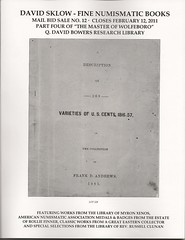 Mail bid sale No. 12 closed February 12, 2011. I would like to take this opportunity to thank all the consignors and bidders! Here is a sampling of the results.
Mail bid sale No. 12 closed February 12, 2011. I would like to take this opportunity to thank all the consignors and bidders! Here is a sampling of the results.
- Lot 24 The Papers of Alexander Hamilton $968
- Lot 34 The Edinburgh Encyclopedia $1800
- Lot 55 The Journals of the Lewis & Clark Expedition $579
- Lot 214 The Colonial Newsletter $440
- Lot 228 The Rare First edition 1881 Andrews on Large Cents $9460
- Lot 471 Deluxe Leather American Half Cents by Cohen $451
- Lot 491 Deluxe Leather Attribution Guide by Gellman and Reiver $473
- Lot 632 Rare Catalog of Badges & Medals of the ANA by Harris $770
- Lot 641 The Numismatist 1899 $429
- Lot 643 The Numismatist 1900 $535
- Lot 644 The Numismatist 1901 $525
- Lot 645 The Numismatist 1902 $525
- Lot 944 Rollie Finner's Howland Wood Silver Medal $825
- Lot 970 The Noyes Large Cent Photographs $2385
Of note is Lot 632 the Neil Harris on ANA Medals & Badges received more bids than any other lot, and the price realized of $770 was reduced from a four figure bid!
Prices realized are available on our web site. Our next sale is scheduled for June 11, 2011. It will feature nearly two hundred lots of numismatic Material from the research library of Q. David Bowers, Including a run of mint director reports 1851-1965, An American bond detector, The paste up plates from the Taylor sale 1987, Numerous bank histories & much more!
DAVID SKLOW – FINE NUMISMATIC BOOKS
P.O. BOX 6321
COLORADO SPRINGS, CO 80934
TEL: (719) 302-5686
FAX: (719) 302-4933
finenumismaticbooks@aol.com
www.finenumismaticbooks.com
BOOK REVIEW: GUIDE BOOK OF U.S. COINS, PROFESSIONAL EDITION, 2ND EDITION
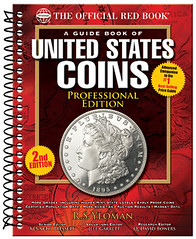 The Official Red Book, Guide Book of United States Coins, Professional Edition, Second Edition, Author R. S. Yeoman, Senior Editor Kenneth Bressett, Valuation Editor, Jeff Garrett and Research Editor Q. David Bowers, 2011, Whitman Publishing Co., Inc, Reviewed by: John and Nancy Wilson
The Official Red Book, Guide Book of United States Coins, Professional Edition, Second Edition, Author R. S. Yeoman, Senior Editor Kenneth Bressett, Valuation Editor, Jeff Garrett and Research Editor Q. David Bowers, 2011, Whitman Publishing Co., Inc, Reviewed by: John and Nancy Wilson
The Second Edition, A Guide Book of United States Coins, Professional Edition book has all the detailed information which would be helpful to professional coin dealers, intermediate and advanced collectors, researchers, auctioneers, libraries and investors. The world's best selling and most popular coin book is a Guide Book of United States Coins. It is published by Whitman on an annual basis, and they report that over 22 million copies of that book are in print. This professional edition allows you to have detailed information not available in the regular edition of the Red Book. The Professional Edition has 384 pages, is Spiralbound 8 1/2 x 11 inches and is done in full color.
Like the First Edition, this Second Edition covers all U. S. federal coin series from the 1/2 cent piece to the gold double eagles. U. S. commemoratives, along with mint and proof sets. Quoting Whitman in regards to this reference:
"New features in the 2nd edition include:
- silver, gold, and platinum bullion coins
- more die variety listings
- dozens of newly upgraded coin photographs
- thumbnail photos of the classic commemoratives
- fully updated pricing, auction data, and certified populations."
All of these added features and other resources provides a wealth of information on every coin type ever made by the U.S. Mint.
The editors mention that this isn't a replacement for the annual Guide Book of U. S. Coins (Red book). It doesn't cover: grading; values for lower graded coins; history of coins; coins from treasures and hoards; colonial & early American coins and tokens; private & territorial gold; hard times & civil war tokens; confederate, Hawaiian, Puerto Rican & Philippine coins; Alaskan tokens; misstrikes & errors; numismatic books and a few other topics.
The three editors, Mr. Bressett, Garrett and Bowers have come together once again to put together a reference that is easy to read and will help you obtain important information in a very fast manner. By having this reference at your fingertips, you will be able to intelligently purchase coins with detailed knowledge on the rarity and availability of coins by condition. Many times the reason for the rarity of coins in a certain condition is also given. Die varieties with close-up photographs and values are given. Sharpness and striking details by date are described.
For every date and mintmark of each denomination, the certified population is given in detail. We are particularly impressed that all this information is available in one place to give a heads-up to anyone who wants accurate, concise and valuable information on any and all U. S. coins which includes bullion. After reviewing this reference, we think that Whitman Publishing has another "best seller" and "must have" reference that will be raved about from one coast to the other.
The 2nd Edition, Guide Book of United States Coins, Professional Edition, retails for $29.95 and is available from book stores, hobby dealers or the publisher at: Whitman Publishing, LLC, 3103 Clairmont Road, Suite B, Atlanta, GA 30329, (800) 546-2995 or visit their web page at: www.whitmanbooks.com
ARTICLE REVIEW: CALIGULA'S QUADRANS
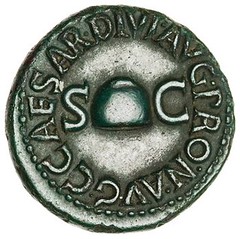

I was pleased to find the latest issue of The Numismatic Chronicle (2010) from the Royal Numismatic Society, in my mailbox today. It has an article by David Woods that offers a new answer to a longstanding numismatic riddle: the meaning and purpose behind the well-known Caligula quadrans of 39-41. I think Woods's paper is an important contribution to Julio-Claudian numismatics that should spur lively discussion. I've summarized the main points of his thesis below:
The coin (see link below to an example in the American Numismatic Society Collection) has on its obverse a pileus, which is a cap given to newly emancipated slaves upon their assumption of citizenship. On the reverse is a bold, though opaquely cryptic, central legend of the letters "RCC", surrounded by the formulaic shorthand description of the emperor's powers and offices.
The purpose of the pileus and the (related or not) meaning of the RCC inscription remain in dispute and have led to differing hypotheses since the late 18th century, with most modern observers echoing the original hypotheses of Eckel from 1796, who thought that the RCC inscription referred to Caligula's remission of the 0.5% sales tax (hence remissa ducentesima), with the pileus a reference to restored liberty deriving from return of elections to the popular comitia from the Senate. Eckel thus thought the obverse and reverse commemorated separate distinct acts of the emperor.
The Eckel explanation for the RCC inscription is commonly found in modern numismatic references, dealer price lists, and auction catalog descriptions. Some of these observers differ from Eckel in interpreting the obverse pileus—holding that the liberty cap depiction also commemorated Caligula's tax relief—or else ignore the question of obverse symbolism altogether. Other authors, including Vagi, are somewhat (and, I think, most appropriately and wisely) cautious, stating that the RCC may be a reference to the tax remission.
Woods points out that classicist and Caligula biographer Anthony A. Barrett took a fresh approach. Barrett quite reasonably felt that the obverse and reverse should refer to the same event and that the event should be contemporary with the earliest issue of the quadrans variety (or late 39 when Caligula assumed the Consulship for the third time). The tax relief was earlier, in 38, and therefore would have been old news, already revoked by the time of the quadrans issue. Early historical records also differ in describing the remitted tax as either 1% or 0.5%.
As for the obverse, Barrett disputed Eckel's interpretation on three different grounds:
1. The populace would not have considered (an essentially cosmetic) restoration of elections to the popular assemblies as liberating;
2. The restoration occurred in 38 (and, again, was "yesterday's news" as of the late 39 date of the first quadrans);
3. The use of a pileus to symbolize liberality—as, for example, tax-relief—was a third century phenomenon, and therefore anachronistic in the context of interpreting first century iconography.
Barrett put forth a new interpretation, unifying the purpose of obverse and reverse elements in celebrating a single contemporary event: the execution of Gaetulicus, Governor of Upper Germany, in late 39, for his plot against Caligula. In this context, the pileus would symbolize the death of a threat to liberty in the same way that it was used by Brutus on the famous Eid Mar denarius to celebrate the execution of Julius Caesar. Barrett found no parallel in contemporary non-numismatic epigraphy for RCC, but suggested that it could be an abbreviation for Restituti Concordia Consensus or something comparable.
Although Woods recognizes that Barrett "pays proper attention to chronology," he finds the arguments and conclusions of Barrett (and his predecessors) unsatisfactory on several grounds and offers a new interpretation of the Caligula quadrans.
Unlike the Eid Mar denarius, the Caligula quadrans lacks daggers. The coin is neither too small for daggers (despite Barrett arguments to the contrary), nor Caligula too timid to use such symbolism (as Woods illustrates). Woods concludes that "daggers played no part in the event that Caligula celebrated." Rather, "one should focus on the symbolism of the pileus itself and not be distracted by the superficial resemblance between the obverse of the quadrans and the reverse of the Brutus denarius."
Barrett, says Woods, also ignores the fact that the reverse and obverse types were limited to the quadrans (one quarter of an as). Wood finds it implausible that such a high level conspiracy by a major figure would be celebrated on the lowly quadrans and not on a denomination used primarily among the army and societal elite, as is normally seen for such numismatic commemorations.
Woods's interpretation of the Caligula quadrans is that the liberty it celebrates is the liberty of all free Roman citizens, with the pileus as a their symbol. He reasons that it was Caligula's crackdown on those illegally claiming citizenship that is the focus of the coin's commemoration. This proper enforcement of the rules of citizenship would theoretically play well among the greater masses of the population who normally encounter the quadrans in everyday exchange.
This same segment of the population might also be most at risk of competition from an influx of false citizens, particularly in a milieu of increasing scarcity. We don't know exactly when the new social measures were implemented by the emperor, but his actions probably coincided with the financial crisis of late 39. This would, of course, be consistent with the chronology indicated by the coins's inscriptions.
As for the meaning of the RCC reverse inscription, Woods posits that it could be Res Civium Conservatae ("The interests of the citizens has been preserved"), or something closely related to this.
I've always wondered how the average Roman citizen would be expected to meaningfully and unambiguously decipher severely abbreviated coin inscriptions, although in the context of the current argument (with the message putatively aimed at a largely illiterate underclass) it may matter little.
Woods's hypothesis for the Caligula quadrans seems quite plausible, and is probably the single best explanation to account for all of the available evidence. Time will tell if it will be accepted or if a more satisfactory argument appears. It should, in any event, lead to a reappraisal of and perhaps greater interest in the coins by the numismatic community.
To view the coin's catalogue entry, see: 1967.153.112 Rome, / 39 / AE,Quadrans (numismatics.org/collection/1967.153.112)
THE VICTORIA CROSS LIBRARY
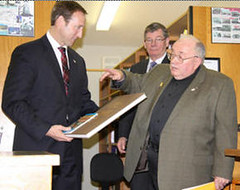 One of the most prestigious military libraries is now calling Prince Edward County home.
One of the most prestigious military libraries is now calling Prince Edward County home.
National Defence Minister Peter MacKay was in Ameliasburgh Friday morning with MP Daryl Kramp to complete the transfer of the Victoria Cross Library from Britain to the Marilyn Adams Genealogical Research Centre.
"The Victoria Cross Library "The Facts Behind the Men Behind the Medals" was compiled by UK historian Tom Johnson and according to Ian Reilly, president of 7th Town Historical Society, contains1,356 books, "some very small and others very large."
"This is such an important collection of books," said Reilly prior to Friday's transfer ceremony. There is so much information here and the history is right at our fingertips."
The Victoria Cross was first awarded in 1856 and is the highest military decoration which is, or has been, awarded for valour "in the face of the enemy" to members of the armed forces of various Commonwealth countries, and previous British Empire territories. It has been awarded to 1,359 people, most recently to Corp. Benjamin Roberts-Smith of Australia on Jan. 23, of this year.
No Canadian has been awarded the Victoria Cross since the end of the Second World War, but there are 94 Canadian recipients of the medal.
The repository of the books of the Victoria Cross library represents the first time the collection has ever left British soil.
To read the complete article, see: Historic library moved to Ameliasburgh (www.intelligencer.ca/ArticleDisplay.aspx?e=2985987)
THE SECRET HISTORY OF THE FIRST U.S. MINT!
THE TOP SELLING NUMISMATIC BOOKS ARE – ALBUMS!
Barnes & Noble ranks its sale of books and updates the list every day. They do this in 60 categories. Coins, currency and stamps is one of those categories.
Guess what? There is only one book in the top ten – Neil Berman and Ron Guth's "Coin Collecting for Dummies." All the rest are albums. Statehood quarters still remain popular. Four of those nine albums are still for statehood quarters. There are three albums by three different makers – Littleton, Whitman, E.J. Harris – and Harris' Statehood Quarter Collectors Map is also included.
Top seller is Littleton's Statehood Quarter album. Littleton has four of the top sellers in the top ten list! Considering that its Statehood Quarter album was introduced 12 years ago, that may be something of a record in the coin field.
By the way, Littleton's Spring 2011 catalog arrived this week. The good people at Littleton have outdone themselves in this 100-page catalog. Every page offers numismatic delights in an appealing way! I don't know how Dave Sundman's crew is able to offer such a vast amount of numismatic material and to create such popular products and appealing catalogs every year. It certainly must be one of the largest numismatic firms in the world.
That is until I saw a photograph of all the firm's employees. They must employ half the population of Littleton, New Hampshire to do what they do in the numismatic field. This writer has been in the numismatic field for 71 years, but I still find something new to acquire in this catalog.
Notably there is only one coin book in the entire catalog – obviously the Red Book. Coin book authors might consider convincing Dave Sundman to sell their books at Littleton as well as all the other fine material they currently stock.
MORE ON DEALER STEVE TANENBAUM
On Facebook David Menchell wrote:
"A tragic and senseless loss. Steve was a good friend to the hobby and a personal friend to many of us. He was always generous with his time and knowledge. A real gentleman and decent human being who will be sorely missed."
Alan Weinberg writes:
"Dave Bowers gave a personal reminiscence at Steve's memorial service and taped video comments were broadcast at the service, including mine."
Dave Bowers writes:
The memorial service was a fine tribute. Steve's extended family was on hand as was a nice contingent of his friends from the numismatic community. A number of us had a chance to speak and share reminiscences. Steve was one of my closest numismatic friends for more than 40 years. He will be forever remembered and honored.
Bill Rosenblum writes:
Steve's death and how it happened is a shock and a terrible loss to the numismatic community. I've known and dealt with both Steve and Rich Rossa since the 1970's as they would more than occasionally have a Jewish related token (Steve) or medal (Rich) that I would be interested in and we would commence negotiations which usually lasted the entire show.
Steve had a sister who lived (perhaps still lives) in Colorado not too far from me. Fifteen or so years ago he was visiting us and they made a special trip up the hill to deliver me a very heavy package of medals. He would visit his sister every year or so and would always tell me he was confounded by the weather here. If he came in the dead of winter, the weather was usually mild and dry but if he visited in April it was usually cold and snowy.
Interestingly a good friend of his sister was the manager of our local insurance company office and Rita and her would talk about numismatics in a 3rd hand way whenever they had occasion to speak. In a less than 6 degrees of separation fact: Rich Rossa's brother was a close friend of mine in college who I still usually meet for breakfast (or lunch or dinner) almost every time I'm back east. And he has not the slightest interest in numismatics.
In another eerie coincidence Steve is the 2nd numismatist (that I am aware of) that was a victim of a hit and run driver in Brooklyn in the past year. Leo Reich, a collector of ancient Jewish coins, was killed sometime last summer by a hit and run driver. I certainly am not trying to make light of it but what are the chances of someone in Colorado knowing 2 people in Brooklyn who have been killed by hit and run drivers?
John Kraljevich writes:
Steve's memorial service was Wednesday afternoon, which gave me the chance to meet Steve's family for the first time. Unsurprisingly, they were incredibly nice folks. While they knew Steve was very into numismatics, they seemed surprised to hear just how well-respected he was. The support of our community has meant a lot to them, and I suspect it will continue to.
Life goes on for the rest of us, but I suspect none of us will be able to look at a token for awhile without thinking of our missing friend.
To read the complete article, see: DEALER STEVE TANENBAUM FELLED BY KILLER IN NEW YORK RAMPAGE (www.coinbooks.org/esylum_v14n07a02.html)
FALLEN PHOTOGRAPHER'S VIRGIN MARY MEDAL RECOVERED IN VIETNAM
Bill Rosenblum writes:
Here's an interesting story of a lost "medal". A little smile helps this day when Rita and I have been thinking of Steve Tanenbaum.
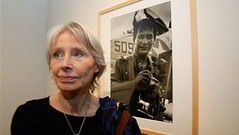 It was a love token worn through the blood-drenched rice paddies and jungles of the Vietnam War.
It was a love token worn through the blood-drenched rice paddies and jungles of the Vietnam War.
For Henri Huet, the Virgin Mary medallion was his one constant link to Cecile, the woman he loved. The celebrated Associated Press photographer carried it in his pocket or hung it around his neck. It was engraved for her baptism and when he left for the war, she gave it to him.
On assignment, the military helicopter Huet was riding in got shot down over Laos. Huet was killed. The medallion the size of a penny disappeared into the thickness of a bamboo forest, where it slept for nearly three decades.
This past week, the gold medallion was again in the hands of Cecile, the culmination of an extraordinary journey that took it across epochs and continents — and whose mystery was unlocked by a long-lost trove of letters.
Duty called later in the year: Huet was sent back to cover the war.
He wanted her to join him in Asia — but not in war-ravaged Vietnam. Parting, she gave him the medallion — a baptismal gift from her godmother, in keeping with Roman Catholic tradition.
They wrote each other letters, hundreds of them. The correspondence lasted nearly three years. She wrote her last letter the day he died — when she woke up in the middle of the night, sensing a "need" to write.
It was Feb. 10, 1971. Huet, 43, had boarded a South Vietnamese military helicopter in the town of Khe Sanh, near the border with Laos, with a mission to inspect efforts by U.S.-backed forces to sever Viet Cong supply lines.
In a flash of anti-aircraft fire, the chopper was gunned down. All four photographers were killed, along with seven Vietnamese troops, one of them a military photographer.
Along with the men, the camera equipment, and the military hardware, a tiny disc of gold also tumbled down from the skies above Laos. On one side was a relief of the Virgin Mary; on the other was etched, "Cecile, nee le 16-6-1947" — French for "born on June 16, 1947."
For 27 years, the keepsake lay on an overgrown Laotian hillside.
To read the complete article, see:
In Vietnam War love story, a medallion comes home
(www.foxnews.com/world/2011/02/13/vietnam-war-love
-story-medallion-comes-home/)
MÜNZKABINETT WINTERTHUR OF SWITZERLAND CELEBRATES 150 YEARS
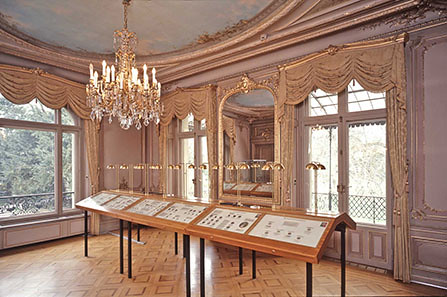
On April 29th, 1861, a young merchant's son, Friedrich Imhoof-Blumer, became the keeper of the coin collection in the municipal library of Winterthur. That collection has since taken on a life of its own and is now known as the "Münzkabinett" (‘Coin Cabinet'). Although it started life within the library, the collection became an independent institution after its transferral to the Villa Bühler in 1862.
150 years have since passed, and the Münzkabinett, which also includes the antiquities collection of Winterthur, is now an active museum with an internationally renowned collection. It hosts exhibitions documenting numerous topics relating to the cultural history of money and also offers museum educational services at all levels. It provides a contact point for scholars and also has an energetic research agenda of its own. This anniversary provides the Münzkabinett with an opportunity to look back at its distinguished past, present its current work to a wider audience and to contemplate what the future may hold in store.
The celebrations commenced on January 2nd with the minting of the first examples of the anniversary medal. On 22nd January, the exhibition, "150 Jahre Sammeln- Geschichten und Höhepunkte", documenting the history of our institution, opened. Our other exhibition, "Gold und Silber- Neues Geld im Spätmittelalter", documenting the development of new forms of money in the late medieval age, is still running. Both exhibitions run until September 2011.
A rich array of events and guided tours will accompany this anniversary year. The guided tours will be led by the museum staff and will cover a variety of interesting themes. A concert will be held in the museum rooms on June 19th, and on 2nd July we will celebrate with a big summer festival in the park surrounding the museum.
This autumn heralds a new and exciting project: on November 3rd, in collaboration with the Münzkabinett of the Kunsthistorischen Museum Wien in Vienna, we will open an exhibition on Greek coinage. In addition, the third volume of our museum catalogue on Greek coinage will be published towards the end of the year.
To read the complete article, see: The Münzkabinett Winterthur celebrates its 150th Anniversary (1861-2011). (www.coinsweekly.com/en/News/4?&id=454)
MORE ON 1945 NICKELS WITHOUT MINTMARKS
Dave Lange writes:
In looking at the images of the two nickels lacking mintmarks, I wonder if it's possible that the photos are mismatched. The obverse of the 1944 and the reverse shown with the 1945 both look like Henning counterfeits, while the obverse of the 1945 and the reverse shown next to it appear to be genuine 1945 coins. I say this based on their color and the obverse lamination, both of which are typical of "war nickels."
Bob Leonard writes:
You have unfortunately scrambled the images of the reverses of the 1944 and 1945 no-mintmark nickels:
You can see easily by the color: the 1944 nickels, made of Monel metal, look an even copper-nickel color, while the 1945 silver nickels are two-tone. On the 1945 reverse (shown as 1944 reverse), the mintmark (S?) is very faint and the E of E PLURIBUS UNUM is barely visible, while the M is worn off entirely. Since your closeup is of the wrong coin, it does not add anything to the discussion.
Query author Craig Chambers writes:
Your readers are astute; indeed, the reverse image on each should be changed. The 1945 reverse is after the 1944 obverse, and the 1944 reverse is after the 1945 obverse. Most likely my error, sorry!
Craig has TWO of the mintmarkless nickels, a 1944 and a 1945. He provided the images below. What do people make of them? Could the 1945 be a previously unrecorded date of the Henning counterfeits? -Editor
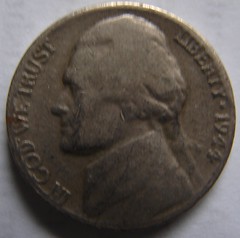
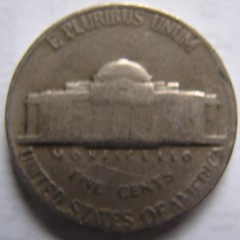
1945 No Mintmark Nickel
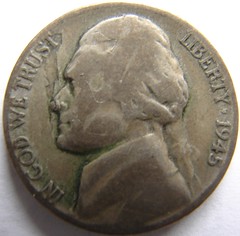

1944 No Mintmark Nickel
Bob Leonard's comments from last week still stand - I'd sent him the raw photos before they got mixed up.
I looked at the images and the 1944 is a "genuine" Henning counterfeit (weak detail on Monticello, copper-nickel color), but the 1945 nickel is a normal Wartime silver nickel, as you can tell by the color. I believe that I can see traces of the mintmark over the dome, though it is quite weak. (Take another look).
Regarding Henning, though, according to an article in Coin World August 28, 1968, p. 33, Henning is known to have made dies with five different dates: 1939, 1944, 1946, 1947, and 1953. (He was afraid that tellers might become suspicious if all the deposits he brought in had the same date.) No 1945 is known.
Of these, the 1944 is the most obvious because it lacks the mintmark and is the wrong color. But the others can be recognized too; this article illustrates one of the 1939 counterfeits. All the Henning counterfeits can be positively identified though weak reverse detail, rough surface, and (in some cases) diebreaks.
Craig Chambers writes:
Not being a photographer, I spent time trying to get the best focused pictures as close as possible with my son's camera (digital, Sony, 5.1 megapixels). I think I see the barest shadow of a mint mark as well, though I cannot with my eyes on a magnifying glass, nor in many shots, but on some of them it does appear as though there might have been a "P" there, which seems so odd since the surrounding raised portions, though worn, are quite distinct.
When I look at the shadow, if it is indeed a mint mark, it appears to be off-kilter, either pointing to the U above instead of the B, or leaning to the right. It does not appear to be in the normal placement, or maybe I'm just seeing things.
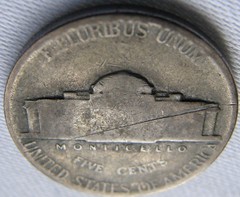 Craig sent me several images, which we'll be happy to share with anyone interested. Here's one which I think does show a slight sign of an S mint mark.
Craig sent me several images, which we'll be happy to share with anyone interested. Here's one which I think does show a slight sign of an S mint mark.
Jonathan Brecher adds:
I raised some similar questions about Henning/non-Henning nickels a few months ago at forums.collectors.com/messageview.cfm?catid=26&threadid=797202 .
To read the earlier E-Sylum article, see: QUERY: 1945 NICKEL WITHOUT MINTMARK INFO SOUGHT (www.coinbooks.org/esylum_v14n07a11.html)
THE BOOK BAZARRE
AN INTERVIEW WITH ANA MONEY MUSEUM CURATOR DOUGLAS MUDD
As the son of an American diplomat, you spent your early years moving from country to country. How did you get involved with numismatics?
Douglas Mudd: My father was a collector of Spanish Colonial and ancient coins – so I was always exposed to coins from a very early age. By the time I was ten, when we were in Bolivia, I would accompany my dad as he visited the various coin dealers that he knew – that was when I acquired my first coin, a Spanish quartillo. Later, when we lived in Syria, I collected a few ancient Roman coins and contemporary Syrian, Egyptian and Lebanese coins.
The National Numismatic Collection contains some of the rarest numismatic pieces in existence. You served as the Collection Manager for the National Numismatic Collection for over 14 years, what was that experience like?
DM: It was fantastic – I was really spoiled by the number and quality of the objects in the collection. From the DuPont/Michaelovich collection of Russian coins and medals to the amazing Chase Manhattan collection and the US Mint cabinet, the National Numismatic collection is just full of rare and historically invaluable items – each of which was waiting for its story to be told! There was some frustration also – it was very difficult to get exhibits done since each idea (no matter how small) had to go through a lengthy review and approval process and then had to wait for the availability of a designer and a fabricator from the exhibits department. The really frustrating part was not having the time to really get to research the collection – I was able to do a little at a time, and being the photographer (another hat I wore while working at NNC), I did get to work with a large part of the collection over the years (over 8,000 slides alone!).
At the Smithsonian, you were responsible for the care, storage and security of 1.6 million items in the numismatic collection. What kind of planning goes into maintaining the integrity of the rarest numismatic items in existence?
DM: Quite a bit! The planning ranges from how to categorize and organize the objects to how to store them and complete periodic checks. With 128 coin cabinets, each with 80 drawers capable of holding up to 80 dollar-size coins – not to mention the storage for the paper money collection (over 2000 linear feet of shelving!), there is a lot to do just to keep track of everything. Some areas are easy to organize, based on how other numismatic museums and collectors organize their collections – others are not so easy – especially items like medals, where there is no standard way to organize all medals.
In 2004, you joined the staff of the American Numismatic Association as the curator of the Edward C. Rochette Money Museum. What was making the move to a considerably smaller museum like?
DM: There is definitely a major difference when moving from a museum like the Smithsonian Institution with thousands of employees to a small museum like the Edward C. Rochette Money Museum, but not as big as you might suppose. Even in large museums, most departments are relatively small and often work fairly independently. The big difference is that at a small museum you will be doing multiple tasks and have fewer resources – conversely, you will not have to go through as many layers of bureaucracy to get things done! At the ANA we can get a single case exhibit done in a week from start to finish – at the Smithsonian the same case might take six months…
To read the complete article, see:
Interview with Douglas Mudd, Curator of the ANA Money Museum
(news.coinupdate.com/interview-with-douglas-mudd
-curator-of-the-ana-money-museum-0688/)
QUERY: MINTAGE FIGURES FOR COMMEMORATIVE DOLLARS 2007-2010 SOUGHT
Ron Abler writes:
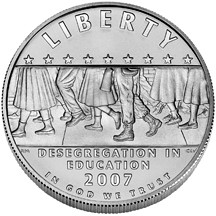 Your announcement in The E-Sylum that the Medal of Honor images are up on the Mint website reminded me of a question that I have asked several collectors and dealers, with no worthwhile answers. (I do not consider "The !@#$%^ Mint just isn't doing its job these days!" to be an informative response.)
Your announcement in The E-Sylum that the Medal of Honor images are up on the Mint website reminded me of a question that I have asked several collectors and dealers, with no worthwhile answers. (I do not consider "The !@#$%^ Mint just isn't doing its job these days!" to be an informative response.)
While this is not the central subject of The E-Sylum, your readers represent the most knowledgeable numismatic experts of which I am aware, and if there is an answer, I am confident they know it. Question: Are the mintage figures for Commemorative Dollars available for the years 2007 through 2010? I have been unable to find them anywhere.
The last mintage figures in the 2011 Redbook are on page 326, ending with the 2006 issues. The "Distribution" columns from 2007 through 2010 are blank.
MORE ON WHO SAID STEPHEN NAGY WAS JOHN HASELTINE'S SON-IN-LAW?
Last week Pete Smith asked:
What was the original source for the statement that Nagy was son-in-law of Haseltine? Did this offer any specifics like the name of Haseltine's daughter and Nagy's wife?
Harold Levi writes:
In my book, The Lovett Cent; a Confederate Story, I repeated the same info about Stephen K. Nagy being John W. Haseltine's son-in-law. At the time, I questioned whether or not this was true since I had found conflicting information in the April 1925 Numismatist obituary for John W. Haseltine that listed his daughter as Mrs. Marion H. Richards of Crawford, NJ.
My footnote on Nagy being Haseltine's son-in-law: Walter Breen, Walter Breen's Complete Encyclopedia of U.S. and Colonial Coins, (New York: Doubleday, 1988), p. 567. In his discussion about the handling of some of the special coins in the Idler estate, Breen states "This 1876 First Transitional went successively to Stephen K Nagy (Haseltine's agent and son-in-law),.,.,.". Another oops for Walter?
Pete Smith adds:
I believe that Breen also stated this in other places. However, I still don't think he was the first. Breen made mistakes, but often they were repetition of earlier mistakes.
Dave Hirt writes:
I enjoyed The E-Sylum as usual. I can always count on it for interesting reading.
About the Stephen K. Nagy/John Haseltine relationship, I long suspected they were not related. I am away from home, so am writing from memory. In Haseltine's obituary in the Numismatist 1924 or 1925, Nagy is not mentioned.
I believe the relationship story started because of their close business association, Nagy could be called Haseltine's prodigy. During the period around 1907-1913 they worked together selling items from the William Idler estate. Idler had been a trusted purchaser used by mint employees to sell coins and patterns "liberated" from the mint.
Another published relationship that I do not believe is correct is that coin dealer Paul Seitz was Tom Elder's son-in law. I will have more to say on this subject in an article I am writing for publication in The Asylum.
To read the earlier E-Sylum article, see: (www.coinbooks.org/esylum_v14n07a10.html)
MOY'S "DIRECTOR'S COIN FOR EXCELLENCE"
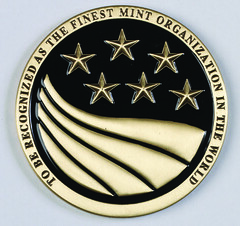
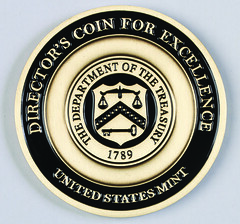
The medal came as a surprise and honor to Harper.
"I returned from the World Money Fair in Berlin to find the medal and a nice note from the former Mint director in my mail," he said. "He thanked me for giving the Mint fair coverage. I would hope that this is every journalist's intent, but if I am being given a medal for it, perhaps not."
The 2-1/4-inch diameter, black and gold color medal depicts the U.S. Treasury Department seal on one side along with the words UNITED STATES MINT DIRECTOR'S COIN FOR EXCELLENCE. The other side features a motif of six raised stars and four banner stripes with the words TO BE RECOGNIZED AS THE FINEST MINT ORGANIZATION IN THE WORLD.
Harper, also executive editor of World Coin News and editor of U.S. Coin Digest and North American Coins and Prices, has been with Krause Publications for more than 30 years.
READER THOUGHTS ON THE GIANT PENNY: IS IT ART?
I agree with YOU about the issue of whether or not the 10' cent reverse reproduction is art. As you said, it is in the mind of the beholder.
Dan Hamelberg writes:
The lady from Michigan that created the 10 foot penny from 84,000 Lincoln cents should be congratulated. What an effort! This is the kind of exhibit that would attract attention at the ANA convention. Someone should contact the Ripley's Museum and make arrangements to display this creation at the summer ANA, and then perhaps at the ANA museum. I think people of all ages would enjoy seeing this, and I believe kids in particular would enjoy it. As we all know, kids are the future of this hobby, and anything that attracts interest is good for the hobby.
A Flag Made of Cents
On a related note, Pete Smith writes:
Bill Himmelwright is the proprietor of Premium Quality Coins in downtown Minneapolis. On the back wall of his shop is a flag 10.5 feet high and 20 feet wide made from 700 pounds of Lincoln cents. Several images can be seen on the following site: www.pqcoin.com/making_history.htm
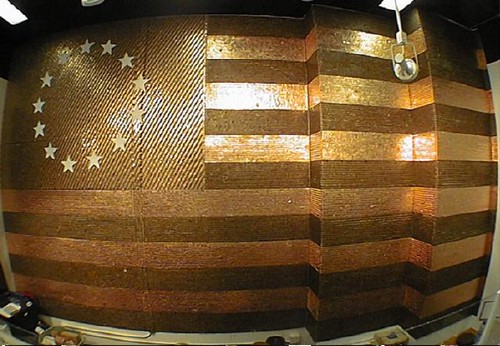
To read the earlier E-Sylum article, see: MICHIGAN MOM'S GIANT PENNY: IS IT ART? (www.coinbooks.org/esylum_v14n07a21.html)
NOTES FROM E-SYLUM READERS: FEBRUARY 20, 2011
Is The Museum of Athens Operating?
Bob Knepper writes:
The February 4 and February 11 E-Sylums mentioned the Numismatic Museum of Athens. Still seeking a source of pictures of modern Greek pattern and off-metal coins, I tried to contact the museum thru both the reply feature at www.nma.gr and using protocol@nm.culture.gr given at http://gogreece.about.com. Both attempts were rejected so I wonder if the museum is still operational. The Greek government and economy are reportedly having serious problems. Does anyone have a contact who could check?
Border's Files for Bankruptcy
Borders Group Inc filed for bankruptcy protection and said it would close about one-third of its bookstores, after years of shriveling sales that made it impossible to manage its crushing debt load.
The long-expected Chapter 11 filing will give the second-largest U.S. bookstore chain a chance to try to fix its finances and overhaul its business in an attempt to survive the growing popularity of online bookbuying and digital formats.
But the chain still faces questions about its longer-term survival in the face of competition from larger rival Barnes & Noble Inc and discounters such as Wal-Mart Stores Inc and Costco Wholesale Corp, as well as from Web retailer Amazon.com Inc and from Apple Inc in electronic books.
Borders President Mike Edward said his chain "does not have the capital resources it needs to be a viable competitor." He said the bankruptcy was essential for Borders to restructure its debt and still operate.
To read the complete article, see: Borders files for bankruptcy, to close 200 stores (news.yahoo.com/s/nm/20110216/bs_nm/us_borders)
Coin Pictures Decapitation (Artistically)
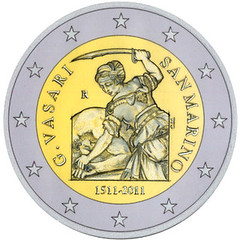 P.K. Saha forwarded this image of an interesting new coin. I was attracted by the design and reference to an artwork. P.K. writes:
P.K. Saha forwarded this image of an interesting new coin. I was attracted by the design and reference to an artwork. P.K. writes:
The coin shows a detail of the painting by Giorgio Vasari (30 July 1511 – 27 June 1574) "Giuditta decapita Oloferne" (Giuditta Decapitates Oloferne). The coin commemorates the 500th birth anniversary of the painter and is likely to be released on 30th July.
Another State Currency Proposal
A South Carolina state politician wants the state to develop its own gold and silver-based currency in case the Federal Reserve collapses and hyper-inflation ensues.
"If folks lose faith in the dollar, we need to have some kind of backup," State Sen. Lee Bright told the Spartanburg Herald Journal's Stephen Largen. His bill asks a committee to look into the development of a state currency, citing the Constitution and Supreme Court precedents to prove the bill's legality.
Slate's Annie Lowrey tracks down similar bills in Georgia and Virginia, and points out that the legislation reflects a larger trend of state politicians wading into monetary policy. A bill in Georgia would require all debts to the state be paid in pre-1965 gold and silver coins. The Virginia proposal would let the state print its own money. Meanwhile, one politician in Utah wants to cut out the middleman entirely and allow the state's residents to run their very own mints.
To read the complete article, see:
South Carolina lawmaker wants separate currency for state
(news.yahoo.com/s/yblog_thelookout/20110214/us_yblog
_thelookout/south-carolina-lawmaker-wants-separate-currency-for-state)
On Saving Original Media
Nick Graver writes:
Those who have their old home movies/slides transferred to DVD and other more modern technologies should still retain the original film. There is every chance that the film will still be surviving long after the newer medium has become technically obsolete, or has deteriorated. Just store the film in your living quarters atmosphere, not the attic, nor the basement, but where you live. Certainly, a low-temperature, low-humidity archive would be best, but not many have that.
THE BOOK BAZARRE
2011 PRESIDENTIAL MEDAL OF FREEDOM AWARD CEREMONY
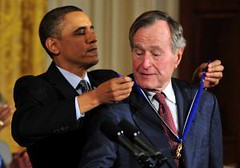 Former President George H.W. Bush, poet Maya Angelou, and sports greats Stan Musial and Bill Russell received the highest U.S. civilian award Tuesday.
Former President George H.W. Bush, poet Maya Angelou, and sports greats Stan Musial and Bill Russell received the highest U.S. civilian award Tuesday.
They joined 11 others Tuesday at the White House in receiving the Presidential Medal of Freedom -- which recognizes people who have made "an especially meritorious contribution to the security or national interests of the United States, world peace, cultural or other significant public or private endeavors." The other recipients include civil rights leader U.S. Rep. John Lewis, D-Ga., visual artist Jasper Johns and billionaire investor Warren Buffett, the White House said.
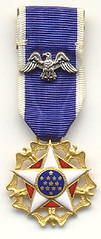 President Barack Obama also gave the award, not limited to U.S. citizens, to German Chancellor Angela Merkel, French-born U.S. cellist Yo-Yo Ma and Auschwitz concentration-camp survivor and humanitarian Gerda Weissmann Klein.
President Barack Obama also gave the award, not limited to U.S. citizens, to German Chancellor Angela Merkel, French-born U.S. cellist Yo-Yo Ma and Auschwitz concentration-camp survivor and humanitarian Gerda Weissmann Klein.
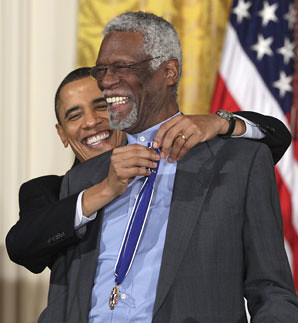
To read the complete article, see: 15 receive Presidential Medal of Freedom (www.upi.com/Top_News/US/2011/02/15/UPI-99531297762200/?dailybrief)
To read the earlier E-Sylum article, see: PRESIDENTIAL MEDALS OF FREEDOM AWARDED IN WHITE HOUSE CEREMONY (www.coinbooks.org/esylum_v12n33a19.html)
AN INTAGLIO FOOD STAMP TEST PLATE
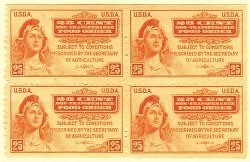 "What happened to this test plate after it was used to make test notes?
"What happened to this test plate after it was used to make test notes?
"When the BEP abandoned the idea of using a Web press...the test press sat in the BEP intaglio research room...and this plate was bolted to the press…"
"How did this test press become privately owned?
"At some point, BEP officials figured that storing the press was not beneficial to the Bureau. The web test press weighed more than 18,000 pounds. So, it was offered for sale. The only likely buyers were firms or individuals involved in the security printing business. A particular family owning a manufacturing firm with interests" in security printing "wanted the press because it contained parts that could be used for their" manufacturing purposes.
"Why was the plate included with the press?
"Why not, the plate could not feasibly be used for any other purpose. The plate itself weighs 112.6 pounds…the buyer got a bill of sale for both the press and the plate."
"Can anyone purchase currency plates or test plates from the BEP?
"Absolutely not! Intaglio plates are the holy grail of security and the BEP will never sell anything like this again. It is truly one of a kind and is the only plate to lawfully come out of the BEP in modern times."
Further correspondence with Craig elicited more details. The first question had to do with the altered $5 Food Coupon with the NON-NEGOTIABLE title as I was really wondering how that fit in the scheme of things. His answer was that it was a proof from a die created to run initially on the BEP Intaglio Test Plate/Hamilton Research Press, not the later Web Currency Press. It was decided not to use that design as it resembled currency or Food Coupons too closely.
My own observations on this piece amplify what Craig wrote. Some words of the nonsense legend are those from an actual Food Coupon but with letters scrambled. Other words do not appear to conform entirely. There is no imprint on this piece, as stated previously, but there is such an indication on the TEST PLATE note indicating coordination from Security-Columbian Banknote Co. on the production of this item. Hamilton Tool Co. required an engraved piece for factory-testing the Research Press at its Hamilton, Ohio facility. The TEST PLATE image was the one approved by the BEP.
I asked how many images were around the test plate. The answer was 18. Craig sent more facts on some of the technical aspects of the development of this 18-subject plate. The images are all the same but with differing depths in groups of three images. These differences help to test for an ideal engraving depth to be used for an intaglio web print and for later development of the Web Currency Press plates. The depth distinctions also helped with the testing for plate wiping which was done both by paper and water, but not at the same time.
Engraving depths went from the lightest at five to 10 microns to the deepest at 50-60 microns. Each group of three images had its own number. Group 1 had the lightest engraving and Group 6 the deepest.
According to Craig, many of the Test Plate notes now held by collectors have severe streaking, almost certainly from testing the water-wipe system. (The BEP uses a water-wipe process for all its intaglio plates.) Part of the development process was to gain knowledge of the water-wipe process for eventual use on the Web Currency Press. Most worldwide intaglio presses uses a paper-wipe system.
Additionally, pieces with "offsetting" have details of notes showing that came from the end of the press going through what Craig called the sheeter assembly. The wheels of this unit were caked with intaglio ink because at the time there was no quick-drying technique available. The plate also had a taper of about 80-90 to 1 from the outside to the inside. This design was used so the plate would fit or securely fasten to the press and heat evenly.
To read the complete article, see: Intaglio Test Plate Surfaces at FUN (www.numismaster.com/ta/numis/Article.jsp?ad=article&ArticleId=17862)
EAST AFRICAN MONETARY UNION PROPOSED
 The East African Community (EAC) Monetary Union programme will be based on the European Union (EU) model where all the partner states will finally relinguish their currencies that will then be replaced with a singe regional currency.
The East African Community (EAC) Monetary Union programme will be based on the European Union (EU) model where all the partner states will finally relinguish their currencies that will then be replaced with a singe regional currency.
"Our proposed approach is to have a regional currency to replace all the other national currencies," said an industry expert who requested for anonymity.
"The EAC Secretariat with support from the International Monetary Fund (IMF) is carrying out a study that will determine the conversion rates of each of the partner states," the expert told East African Business Week in an interview last week in Arusha, Tanzania.
The expert revealed that replacing the currency will be among the last stages but the Monetary Affairs Committee (MAC) subcommittee is working preparatory works on convergence while another subcommittee is working on currency and bank notes.
At the changeover the old national prices will be dropped and East Africans will remain with the new currency pinned on the products for selling rates. This means that in the meantime the national currencies will run parallel with the EA Currency while at the same time the banking system in the region is withdrawing the national currencies, as Uganda and Tanzania are currently doing with the introduction of the new notes.
"However this would require changes in the infrastructure for example Automated Teller Machines (ATM's) to accept the new notes and this is being addressed by the preparatory subcommittee on payments and settlements, and the currency and coins subcommittee," the expert explained.
To read the complete article, see:
Single currency to replace national EAC currencies
(www.busiweek.com/11/index.php?option=com_content&view=
article&id=407:single-currency-to-replace-national-eac-currencies&catid=95
:eac-issues&Itemid=1296)
FEATURED WEB SITE: COMMUNION TOKENS
This week's Featured Web Site is a short history of Communion tokens. It was suggested by Arthur Shippee, who writes:
In a recent sermon in our Presbyterian church, our co-pastor mentioned Communion tokens. The tokens showed one was in good standing, and was submitted to be able to receive communion. Do any of our readers collect these?

John Calvin first recommended Communion tokens with the intent that no unworthy person would be admitted to the communion service. They were first use in the Reformed Church of France in the year 1560. The Dutch used tokens in Amsterdam as early as 1586. England and Ireland began to use communion tokens near the end of the 16th century when authorities found it useful to know who did or did not conform to the legal for of worship of the state church.
But it was in the Presbyterian Churches of Scotland that communion tokens were most widely used. Many believe that there may have been a second reason for using tokens, and that was to protect communicants from betrayal by spies during periods of religious persecution. Communion tokens were used in the Presbyterian Churches of Scotland until World War I. A number of other churches have issued tokens in recent years, but these are normally replicas to commemorate a centennial or some other anniversary.
Communion tokens have been used in Great Britain, Ireland, France, Germany, Greece, Netherlands, Italy, Africa, India, South America, the West Indies, Australia, New Zealand, and Canada. Churches in at least 24 states in the United States issued communion tokens, with over 400 recorded varieties in Pennsylvania. Tokens were used by churches in Freeport, Deer Creek, Glade Run, and Parnassus, plus six different churches in Pittsburgh and three in Allegheny City. But it was in Scotland where the tokens had their deepest roots with over 7000 different types being recorded.
www.tmethvin.com/methvin/
methven_church_token.html

